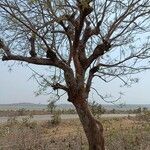| Therapeutic use
|
Diuretics (aerial part), Abdominal pain (bark), Abortifacient agents (bark), Analgesics (bark), Anti-bacterial agents (bark), Antifungal agents (bark), Anti-inflammatory agents (bark), Antineoplastic agents (bark), Antiviral agents (bark), Appetite stimulants (bark), Asthenia (bark), Asthma (bark), Astringents (bark), Burns (bark), Common cold (bark), Contraceptive agents (bark), Contusions (bark), Cough (bark), Dental caries (bark), Diarrhea (bark), Dysentery (bark), Dyspepsia (bark), Ear diseases (bark), Edema (bark), Elephantiasis (bark), Endophthalmitis (bark), Exanthema (bark), Eye infections (bark), Eye pain (bark), Fever (bark), Fractures, bone (bark), Gingivitis, necrotizing ulcerative (bark), Gout (bark), Hematuria (bark), Hemorrhoids (bark), Hemostasis (bark), Hypotension (bark), Hypothermia (bark), Impetigo (bark), Leprosy (bark), Leprosy, lepromatous (bark), Leukorrhea (bark), Mouth diseases (bark), Pain (bark), Pharyngitis (bark), General tonic for rejuvenation (bark), Skin diseases (bark), Snake bites (bark), Sprains and strains (bark), Stomach diseases (bark), Stomatitis (bark), Tetanus (bark), Toothache (bark), Ulcer (bark), Vomiting (bark), Wound healing (bark), Wounds and injuries (bark), Dyspepsia (flower), Hypersensitivity (flower), Appetite stimulants (fruit), Dyspepsia (fruit), Elephantiasis (fruit), Fractures, bone (fruit), Toothache (fruit), Ulcer (fruit), Analgesics (leaf), Anti-inflammatory agents (leaf), Antineoplastic agents (leaf), Antipyretics (leaf), Antirheumatic agents (leaf), Arthritis (leaf), Cardiovascular system (leaf), Contusions (leaf), Dental caries (leaf), Diarrhea (leaf), Dysentery (leaf), Edema (leaf), Elephantiasis (leaf), Fever (leaf), Gonorrhea (leaf), Gout (leaf), Hemorrhoids (leaf), Hypothermia (leaf), Inflammation (leaf), Neoplasms (leaf), Neuralgia (leaf), Pain (leaf), Pharyngitis (leaf), Sprains and strains (leaf), Stomach diseases (leaf), Toothache (leaf), Ulcer (leaf), Wounds and injuries (leaf), Antirheumatic agents (plant exudate), Asthma (plant exudate), Astringents (plant exudate), Dental caries (plant exudate), Galactogogues (plant exudate), Gastrointestinal hemorrhage (plant exudate), Gout (plant exudate), Lactation disorders (plant exudate), Poliomyelitis (plant exudate), Toothache (plant exudate), Wounds and injuries (plant exudate), Dental caries (root), Dysentery (root), Wounds and injuries (root), Burns (stem), Coma (stem), Common cold (stem), Contraceptive agents (stem), Cough (stem), Diarrhea (stem), Dysentery (stem), Emetics (stem), Fever (stem), Fractures, bone (stem), Narcotics (stem), Pain (stem), Tetanus (stem), Toothache (stem), Ulcer (stem), Wound healing (stem), Wounds and injuries (stem), Antidote (unspecified), Astringent (unspecified), Bruise (unspecified), Carbuncle (unspecified), Convulsion (unspecified), Diarrhea (unspecified), Dysentery (unspecified), Elephantiasis (unspecified), Hematuria (unspecified), Rinderpest (unspecified), Sore (unspecified), Swelling (unspecified), Wound (unspecified), Cholera (unspecified), Dentifrice (unspecified), Abdominal pain (unspecified), Anti-bacterial agents (unspecified), Anticonvulsants (unspecified), Antidepressive agents (unspecified), Anti-infective agents, local (unspecified), Anti-inflammatory agents (unspecified), Antineoplastic agents (unspecified), Antirheumatic agents (unspecified), Astringents (unspecified), Fractures, bone (unspecified), Leprosy, lepromatous (unspecified), Toothache (unspecified), Wounds and injuries (unspecified)
|



